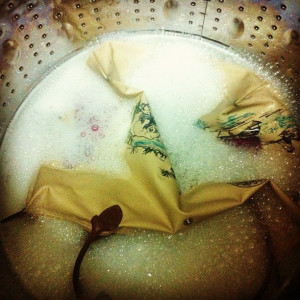Un récent arrêt de la Cour de Paris devrait retenir l’attention des stylistes de mode salariés ainsi que de leurs employeurs.
Dans cette affaire, un styliste avait été embauché comme styliste accessoires en 2013 par une entreprise française de prêt-à-porter et d’accessoires féminins. Il avait, selon lui, créé en septembre 2014 « une paire de basket vintage », dessinée pour évoquer les années 80, mais avait réinterprété le modèle « en [le] déstructurant totalement pour parvenir à une forme innovante et originale. » Le modèle, appelé Slash et qui connut un grand succès, apparut pour la première fois dans la collection Printemps/Été 2015 de la société.
Le styliste prétendait être l’auteur de ce modèle, ainsi que de son sac d’emballage et de sa semelle d’inspiration léopard. Il assigna la société en contrefaçon de droit d’auteur et de dessins et modèles, prétendant en outre que les dessins et modèles français de ces trois articles, déposés auprès de l’INPI, devaient lui être transférés. Il fut débouté de ses demandes en juin 2019 par le Tribunal de grande instance de Paris et interjeta appel. La Cour d’appel de Paris confirma l’arrêt du TGI de Paris le 5 mars 2021.
Selon la société intimée, la basket Slash avait été créée par la directrice du style, qui, selon les termes de son contrat, avait la charge de diriger l’équipe des stylistes, y compris l’appelant, dont le propre contrat spécifiait qu’il était « rattaché à la directrice du style ».
La Cour d’appel de Paris rappela tout d’abord qu’une œuvre est protégée par le droit d’auteur, sans qu’aucune formalité n’ait à être accomplie, pour peu qu’elle soit originale. L’auteur doit néanmoins rapporter « la preuve d’une création déterminée à une date certaine et (…) caractériser l’originalité de cette création ».
En l’espèce, la Cour nota qu’il n’était pas possible d’attribuer la paternité des semelles léopard au styliste, car les dessins qu’il avait produits n’étaient ni signés, ni datés. Cet arrêt nous informe que les professionnels de la mode soucieux de pouvoir prouver la paternité de leurs créations doivent avoir à cœur de dater et signer leurs dessins et croquis.
L’auteur doit également pouvoir prouver qu’il a créé l’œuvre. Dans cette affaire, la directrice du style avait témoigné qu’elle avait discuté de la basket Slash avec le styliste, tout d’abord pour échanger leurs idées sur les matières et les formes, puis, lors d’un second entretien, afin qu’elle valide le croquis du styliste. La société avait en outre produit un courriel envoyé par le styliste demandant à la directrice du style d’approuver le modèle de la boîte à chaussure, où il référait en outre à l’équipe de style qui avait « souhaité revoir la couleur des lacets etc… »
La Cour d’appel avait conclu que « l’autonomie créatrice [du styliste] [était] restreinte, puisqu’il devait obtenir l’approbation de la directrice du style et de l’équipe de style et « travaillait en collaboration avec l’équipe de style de la société et sous la subordination de sa directrice de style ». Le styliste « n’établit pas la titularité des droits d’auteur sur la basket Slash, la boîte/sac d’emballage, et la semelle léopard créées pour la collection (…) de printemps-été 2015. »
Bien que l’arrêt n’ait pas donné raison au styliste, il est tout de même intéressant à connaître pour les créateurs de mode salariés. En effet, la Cour d’appel précisa que :
« (…) l’existence d’un contrat de travail n’est pas exclusive de la protection par le droit d’auteur et le salarié est investi des droits de propriété incorporelle institués au bénéfice de l’auteur pour peu qu’il ait fait œuvre de création en conservant sa liberté et sans que les choix esthétiques opérés ne lui aient été imposés par l’employeur ».
Ainsi, un styliste salarié peut-être titulaire du droit d’auteur sur les modèles créés, si tant est qu’il a conservé sa liberté et que l’employeur ne lui a pas imposé « les choix esthétiques opérés ». Les stylistes bénéficieront sans doute de tenir un journal personnel de création et de noter les étapes qui ont abouti à la création d’un modèle, un procédé utile aux entreprises employant des stylistes salariés afin de pouvoir prouver avoir imposé leurs choix esthétiques à leurs employés.
Cour d’appel de Paris, pôle 5, 2e ch., 5 mars 2021, 19/17254 (D20210011), Michaël A c. C. des c. SAS, confirmant le jugement du 28 juin 2019 du Tribunal de grande instance de Paris, 3ème chambre, 3ème section , RG n° 17/12374


 New York Attorney. Educated in France and in the U.S. I miss baseball when I am in France and runny cheese when I am in the U.S.
New York Attorney. Educated in France and in the U.S. I miss baseball when I am in France and runny cheese when I am in the U.S. I am a lawyer, and this blog is (mostly) about law, but nothing I write on the blog is legal advice. I hope you’ll find what I write to be of interest, but do not rely on it. For more information, please visit the
I am a lawyer, and this blog is (mostly) about law, but nothing I write on the blog is legal advice. I hope you’ll find what I write to be of interest, but do not rely on it. For more information, please visit the 



